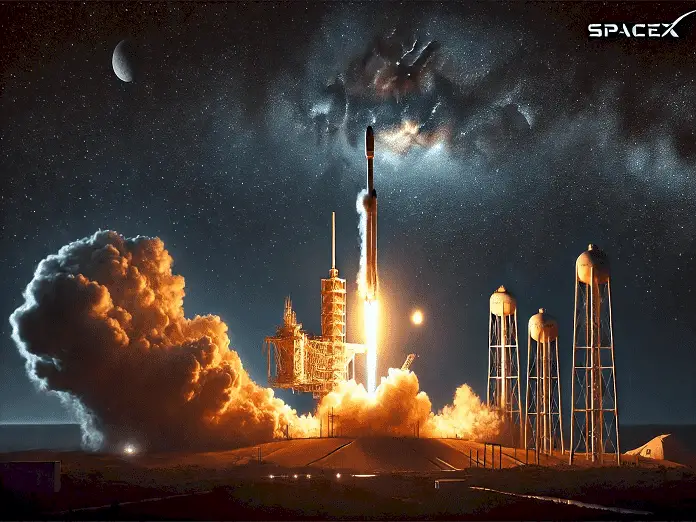SpaceX Falcon 9 Rocket Launch
On December 23, 2024, at 12:35 a.m. EST, SpaceX achieved another significant milestone in its mission to provide global internet coverage. The company launched 21 Starlink satellites from NASA’s Kennedy Space Center in Florida, further expanding its low Earth orbit (LEO) constellation. This launch, designated Starlink 12-2, underscores SpaceX’s commitment to enhancing global connectivity and revolutionizing internet access worldwide.
The Launch: Technical Details and Execution |SpaceX Falcon 9 Rocket Launch
SpaceX Falcon 9 Rocket Launch

The mission commenced with the liftoff of a Falcon 9 rocket from Launch Complex 39A at Kennedy Space Center. The rocket’s first stage booster, designated 1080, executed a flawless ascent, marking its 14th flight. Notably, this booster had previously supported missions such as Axiom-2, Axiom-3, and several Starlink deployments. Approximately eight and a half minutes after liftoff, the booster successfully landed on SpaceX’s droneship, “Just Read the Instructions,” stationed in the Atlantic Ocean. This achievement highlights SpaceX’s advancements in reusable rocket technology, contributing to the reduction of spaceflight costs and the acceleration of mission cadence.SpaceX Falcon 9 Rocket Launch
Following booster separation, the Falcon 9’s upper stage continued its journey, deploying the 21 Starlink satellites into a 293 by 284-kilometer orbit with a 43-degree inclination. The deployment occurred approximately 65 minutes after launch, integrating these satellites into the expanding Starlink network. This constellation aims to provide high-speed internet access to underserved and remote regions globally.
Advancements in Satellite Technology | SpaceX Falcon 9 Rocket Launch
Among the 21 satellites launched, 13 are equipped with Direct-to-Cell capabilities. This technology enables smartphones to connect directly to the Starlink network, bypassing traditional ground-based cell towers. Such advancements are poised to enhance mobile connectivity, especially in areas where terrestrial infrastructure is limited or non-existent. SpaceX’s collaboration with T-Mobile to initiate a beta text messaging service via these satellites marks a significant step toward integrating satellite internet with everyday mobile communication.
Implications for Global Connectivity | SpaceX’s Starlink 12-2 Mission: A Milestone in Global Connectivity
The successful deployment of these satellites is a testament to SpaceX’s dedication to bridging the digital divide. By expanding the Starlink constellation, SpaceX aims to provide reliable and high-speed internet access to regions that have traditionally been underserved by conventional internet service providers. This initiative has the potential to transform sectors such as education, healthcare, and commerce by offering equitable access to information and services.
Environmental Considerations and Mitigation Efforts
While the expansion of satellite constellations like Starlink offers numerous benefits, it also raises environmental concerns, particularly regarding space debris. SpaceX has implemented measures to mitigate these risks, including designing satellites with deorbiting capabilities to ensure they re-enter Earth’s atmosphere and burn up at the end of their operational life. Additionally, the company has committed to adhering to guidelines set by space agencies to minimize the creation of space debris, thereby contributing to the long-term sustainability of space operations.
Looking Ahead: The Future of Starlink
As of December 2024, the Starlink network comprises over 6,800 active satellites, with plans for continued expansion. SpaceX’s ambitious goal is to deploy a constellation of approximately 12,000 satellites, with discussions about extending this number to 42,000 to enhance global coverage and service quality. The ongoing development and deployment of Starlink satellites represent a significant leap forward in satellite internet technology, promising faster speeds, lower latency, and more reliable connections for users worldwide.
Future Prospects
SpaceXMicroGEO Satellites SpaceX Postpones to Dec 22 continues to advance its Starlink project with plans for additional launches in the coming months. Each mission contributes to the development of a robust satellite network designed to deliver high-speed internet access to users around the globe. The integration of direct-to-cellphone technology represents a significant step forward in bridging the digital divide and ensuring connectivity in remote and rural areas.
Conclusion
The successful launch of the Starlink 12-2 mission exemplifies SpaceX’s unwavering commitment to revolutionizing global internet connectivity. Through technological innovation and strategic partnerships, SpaceX continues to pave the way for a more connected world, ensuring that high-speed internet access becomes a universal utility, irrespective of geographic location.
